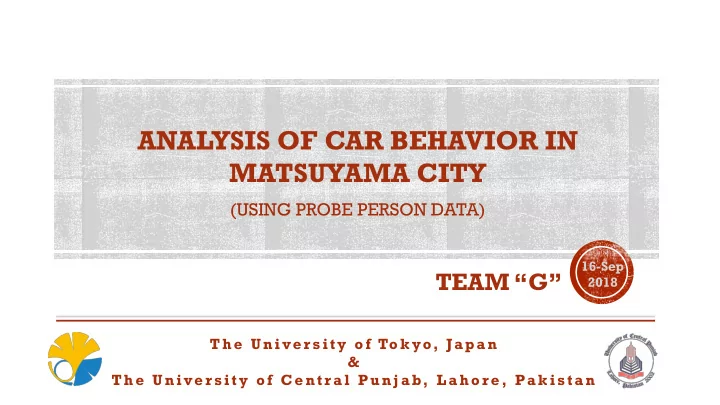

ANALYSIS OF CAR BEHAVIOR IN MATSUYAMA CITY (USING PROBE PERSON DATA) 16-Sep TEAM “G” 2018 The Unive r sity o f To kyo, Japan & The Unive r sity o f Ce ntr al Punjab, Laho r e, Pakistan
GROUP INTRODUCTION Ahsan Umer 1 University of Central Punjab, Lahore Pakistan Ali Habib 2 Khan Shehroze Khalid 3 The University of Tokyo, Abbasi Babar 4 Japan Yamamoto Shotaro 5 1
TARGET AREA MATSUYAMA CITY ➢ Located in Ehime Prefecture on Shikoku Island (Western part of Japan) ➢ Capital and Largest City of Ehime Prefecture with Population = 516, 643 (as of January 1, 2014), Area = 429.06 m 2 and No. of Households = 229,916. ❖ According to the PT survey conducted in 2007, car usage is more than half showing the Expanding Car Usage in Matsuyama City 2
DATA CHARACTERISTICS & PREPARATION Data (Given for Exercise) Central Area of FOCUS Matsuyama City Network Data Probe Person (PP Data) Extraction of Data Location Data Trip Data (Sequential GPS Log i.e. Latitude & (OD, Duration, Mode, Purpose) Longitude) Extracted the OD Data and Combination Network Data for Central Area of Matsuyama City Path Choice Can be Assumed Reason of Extraction Problem Approach How to assume Data Preparation for reducing Map Matching the Actual Algorithm computational load on RL Model 3 Path?
INTRODUCED POLICIES Attempts to make Car Flow Focus on Central some roads Restraint Pedestrian Area (In central Friendly Area) 4
PRELIMINARY ANALYSIS Whole City Central Area Legend Percentage shared by each Mode Percentage shared by each Mode 5 Purpose of Trip Purpose of Trip
FORMULATION OF MODEL Sequential Route Existing Route Spatial Cognition about downstream, IIA, Path Enumeration Choice Models Choice Models Degree of Spatial Cognition ➢ 𝜸 -SCALED RECURSIVE LOGIT MODEL; OYAMA AND HATO 2016 ➢ Consider a directed connected graph; 𝐻 = 𝐵, 𝑂 , where 𝐵 − set of links, 𝑂 − set of nodes ➢ The instantaneous random utility of a link 𝑏 𝑘 condition on being in state 𝑏 𝑘−1 is given by, 𝒗 𝒐 𝒃 𝒌 |𝒃 𝒌−𝟐 = 𝒘 𝒐 𝒃 𝒌 |𝒃 𝒌−𝟐 + 𝝂𝜻 𝒐 𝒃 𝒌 ➢ The total utility of link 𝑏 𝑘 given the state 𝑏 𝑘−1 is formulated by sum of the instantaneous utility 𝒗 𝒐 𝒃 𝒌 |𝒃 𝒌−𝟐 and maximum 𝒆 𝒃 𝒌 expected downstream utility up to the destination link 𝑒 , denoted as value function 𝑾 𝒐 and defined by the Bellman 𝜸 is time discount rate represents 𝒆 𝒃 𝒌 = 𝐅 𝒆 𝒃 𝒌+𝟐 + 𝝂𝜻 𝒐 𝒃 𝒌+𝟐 equation (Bellman, 1957); 𝑾 𝒐 𝐧𝐛𝐲 𝒘 𝒐 𝒃 𝒌+𝟐 |𝒃 𝒌 + 𝜸𝑾 𝒐 ∀𝒃 𝒌 𝝑𝑩 the spatial cognition of driver for 𝒃 𝒌+𝟐 ∈𝑩 𝒃 𝒌 downstream links ➢ LINK CHOICE PROBABILITY (MULTINOMIAL LOGIT MODEL) 𝟐 𝒆 𝒃 𝒌+𝟐 𝝂 𝒘 𝒐 𝒃 𝒌+𝟐 |𝒃 𝒌 +𝜸𝑾 𝒐 𝒇 𝒆 𝒃 𝒌+𝟐 |𝒃 𝒌 = 𝑸 𝒐 𝟐 𝒆 𝒃 𝒌+𝟐 ′ ′ 𝝂 𝒘 𝒐 𝒃 𝒌+𝟐 |𝒃 𝒌 +𝜸𝑾 𝒐 σ 𝒃 𝒌+𝟐 ∈𝑩 𝒃 𝒌 𝒇 ′ 6
PRELIMINARY ESTIMATION RESULTS Variables Parameters t-Value -0.1106528 Travel Time -7.2201359 ** -0.6584271 Right-Turn Dummy -6.194608 ** β 0.4506658 -2.60758 ** L (0) -1268.621 LL -1203.331 Rho-Square 0.05146568 Adjusted Rho-Square 0.04910091 7
INTRODUCED POLICIES Making “Transit Car Flow Focus on Central Mall” Restraint PROPOSED Area of (A Pedestrian Friendly Matsuyama City (In central POLICY area) Area) Hanazonomachi Avenue PRECEDING POLICY Reduced the No. of Car Lanes from 4 to 2 8
TRAFFIC ASSIGNMENT ➢ 𝜸 -SCALED RECURSIVE LOGIT MODEL; OYAMA AND HATO 2016 𝒗 𝒐 𝒃 𝒌 |𝒃 𝒌−𝟐 = Ѳ 𝒖𝒖 𝒃 𝒌 |𝒃 𝒌−𝟐 ∗ 𝑼𝑼 + Ѳ 𝑺𝑼 𝒃 𝒌 |𝒃 𝒌−𝟐 ∗ 𝑺𝑼 + 𝝂𝜻 𝒐 𝒃 𝒌 𝟐 𝒆 𝒃 𝒌+𝟐 𝝂 𝒘 𝒐 𝒃 𝒌+𝟐 |𝒃 𝒌 +𝜸𝑾 𝒐 𝒇 𝒆 𝒃 𝒌+𝟐 |𝒃 𝒌 = 𝑸 𝒐 𝟐 𝒆 𝒃 𝒌+𝟐 ′ ′ 𝝂 𝒘 𝒐 𝒃 𝒌+𝟐 |𝒃 𝒌 +𝜸𝑾 𝒐 σ 𝒃 𝒌+𝟐 ∈𝑩 𝒃 𝒌 𝒇 ′ 𝒆 𝒃 𝒌+𝟑 𝟐 𝝂 σ 𝒃 𝒌+𝟑 ∈𝑩 𝒃 𝑲+𝟐 𝒇 𝒘 𝒐,𝒆 𝒃 𝒌+𝟑 |𝒃 𝒌+𝟐 +𝜸𝑾 𝒐 a j+1 ≠ 𝑒 𝒆 𝒃 𝒌 = ቐ 𝒇 𝑾 𝒐,𝒖 𝟏 a j+1 = 𝒆 𝐴 = 𝐍𝐴 + 𝐜 𝐴 = (𝑱 − 𝑵) −𝟐 ∗ 𝒄 𝐉 − 𝑸 𝑼 𝐆 = 𝐇 Link Flows Equation: 9
POLICY SIMULATION – (CASE-0) Central Area ( Without any change ) 10
POLICY – (CASE-1) Prohibit Cars in two (2) links ( The road in front of Central Station ) 11
POLICY SIMULATION – (CASE-1) 12
POLICY – (CASE-2) Prohibit Cars in ten (10) links ( Case-1 + Hanazonomachi Avenue ) 13
POLICY SIMULATION – (CASE-2) 14
POLICY – (CASE-3) Prohibit Cars in sixteen (16) links ( Case-1,2 + Making a Small Traffic Cell ) 15
POLICY SIMULATION – (CASE-3) 16
POLICY – (CASE-4) Prohibit Cars in sixty (60) links (Making a Large Traffic Cell ) 17
POLICY SIMULATION – (CASE-4) 18
VISUALIZATION OF FLOW CHANGE CASE-0 CASE-1 CASE-4 CASE-2 CASE-3 19
TH THANK NK YOU
Recommend
More recommend